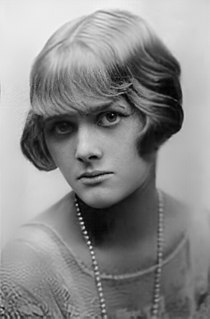
Dame Daphne du Maurier,, also known as Lady Browning after her husband was knighted in 1946, was an English novelist, biographer and playwright. Her parents were actor-manager Sir Gerald du Maurier and his wife, actress Muriel Beaumont. Her grandfather was George du Maurier, a writer and cartoonist.

Dame Margaret Drabble, Lady Holroyd, is an English biographer, novelist and short story writer.

Mrs Dalloway is a novel by Virginia Woolf, published on 14 May 1925, that details a day in the life of Clarissa Dalloway, a fictional upper-class woman in post-First World War England. It is one of Woolf's best-known novels.

Margaret Forster was an English novelist, biographer, memoirist, historian and critic, best known for the 1965 novel Georgy Girl, made into a successful film of the same name, which inspired a hit song by The Seekers. Other successes were a 2003 novel, Diary of an Ordinary Woman, biographies of Daphne du Maurier and Elizabeth Barrett Browning, and her memoirs Hidden Lives and Precious Lives.

The Voyage Out is the first novel by Virginia Woolf, published in 1915 by Duckworth.
Hampstead novel is a term used – often in a derogatory sense – to describe a particular genre of English fiction. Journalist and literary critic Kate Kellaway has described it as "a middle-class morality novel – probably involving adultery and shallow-masquerading-as-deep." Author and journalist Bill Buford calls it "middle class monologue". A novel in this genre takes place in the affluent Hampstead area of London, or in a similar neighbourhood. One novelist who is particularly often associated with the Hampstead novel is Margaret Drabble. Other authors considered proponents of the style include Margaret Forster, Fay Weldon, Penelope Lively, Kingsley Amis, Ian McEwan, Melvyn Bragg and Zoë Heller.

The Peppered Moth is a 2000 novel by English writer Margaret Drabble; it is her fourteenth published novel. The novel follows the fictional experiences of three generations of women within one family, and contains several elements that are loosely based on Drabble's own biographical experience.

Jerusalem the Golden is a novel by Margaret Drabble published in 1967, and is a winner of the James Tait Black Memorial Prize in 1967.
Bernardine Anna Livia Mary Bishop was an English novelist, teacher and psychotherapist. Her first novel, Perspectives, was published by Hutchinson in 1961. During a half-century break between publishing her first two novels and her third, the 2013 Costa prize-nominated Unexpected Lessons In Love, she brought up a family, taught, and practised as a psychotherapist.
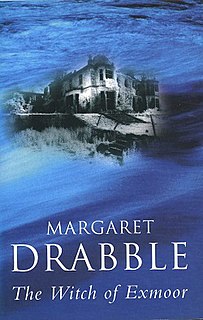
The Witch of Exmoor is a 1996 novel by Margaret Drabble. The novel is a social novel, with a focus on exploring the state of post-Thatcher Britain through the Dickensian satire of the Palmer family. The title describes the satirical protagonist, Frieda Palmer, who provides the source of much of the social commentary.
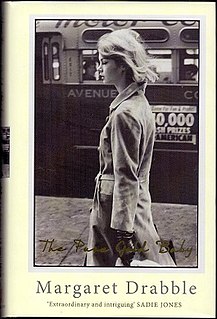
The Pure Gold Baby is British novelist Margaret Drabble's 18th novel, first published in 2013. The novel was her first novel to be published in seven years, following The Sea Lady. In 2009, Drabble had pledged not to write fiction again, for fear of "repeating herself."
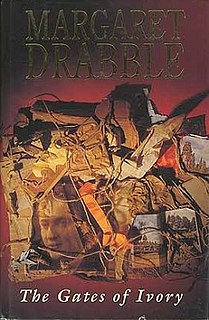
The Gates of Ivory is a 1991 novel by novelist Margaret Drabble. The novel is the third in a series of novels, following The Radiant Way and A Natural Curiosity. The novel continues the stories of several middle aged intellectuals introduced in the last two novels. The novel also introduces a new character, Stephen Cox who is loosely based on J.G. Farrell.

The Garrick Year is the second novel by British novelist Margaret Drabble, first published in 1964. It is a first-person account of Emma, a London wife and mother examining the fraught bits of her marriage and an affair.

The Waterfall is a 1969 novel by British novelist Margaret Drabble. The novel is one of Drabble's more experimental narratives, starting as a third person narrative but quickly dominated by a first person protagonist Jane Gray, to guide the reader through her love affair and life.
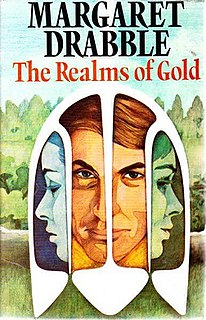
The Realms of Gold is a 1975 novel by British novelist Margaret Drabble. The novel explores the mid-life experiences of anthropologist Frances Wingate and her affair with Karel Schmidt.

The Radiant Way is a 1987 novel by British novelist Margaret Drabble. The novel provides social commentary and critique of 1980s Britain, by exploring the lives of three Cambridge-educated women with careers as knowledge professionals.
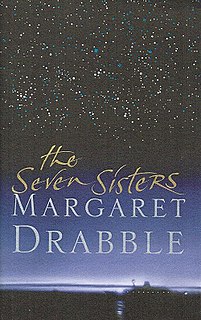
The Seven Sisters is a 1992 novel by British novelist Margaret Drabble. The novel reflects on a mid-life crisis of an estranged Candida, when she moves to a rundown London apartment. The novel largely follows Candida's evasive and sometimes deceptive representation of events, including an epistolary section which is her "computer diary".

A Natural Curiosity is a 1989 novel by Margaret Drabble. The novel is an unintended sequel to Drabble's 1987 novel The Radiant Way, follows the lives of the three protagonist women first introduced in that novel. The novel continues Drabble's interest in exploring the contemporary experience of the British middle class through the eyes of women.

The Ice Age is a 1977 novel by British novelist Margaret Drabble. The novel follows the experiences of former BBC producer Anthony Keating as he experiences the ups and downs of life during the 1960s and 1970s. Depicting the property crisis in Britain during that period, novel diverges from her earlier psychological studies of individuals, focusing more on the "state of England".
The Book of Colour is a novel by British author Julia Blackburn, published in 1995 by Pantheon Books. Blackburn's first novel, the book was praised by critics and shortlisted for the Women's Prize for Fiction.

















